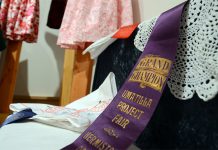The Tamástslikt Cultural Institute in Pendleton will explore the link between clothing, cultural identity, and history through a rich selection of Native American hats, bonnets, headdresses, war shirts and moccasins from the High Desert Museum’s acclaimed Doris Swayze Bounds Collection.
The exhibit, Head to Toe: The Language of Plateau Indian Clothing, opens on Friday, Nov. 8. Admission is free for the opening day and the public is invited to the opening reception at 6 p.m. with complimentary refreshments.

Clothing from Tamástslikt Cultural Institute in Pendleton also is included in the exhibit, offering a look at the rich traditions of the Cayuse, Umatilla and Walla Walla tribes.
Doris Swayze Bounds spent most of her life in Oregon, and formed close associations with Plateau Indians and other regional tribes before she died in 1994. She was not of Native American ancestry, but was adopted into the Blackfeet Tribe during a special ceremony in 1965. Through her close acquaintances and passion for Native arts from the Columbia Plateau, she amassed her remarkable collection.
Head to Toe features the collection’s ceremonial and everyday clothing that demonstrate creative ingenuity and style unique to Plateau Indians. More than 20 Plateau Indian tribes lived in the region bordered by the Cascade and Rocky Mountains, and shared similar approaches to making clothes for warm days and cold nights. For example, Plateau Indian moccasins may be lined with fur, with unpadded soles, a collar tied above the ankle for protection from brush or rock and decorated with porcupine quills in geometric shapes. As new materials such as glass beads became prevalent through trade with immigrants, Plateau Indians experimented with new patterns.
During special events, women often wore twined basket hats with a zigzag pattern, traditionally made from bear grass and woven into an elongated shape. More recently, they have been made from commercially available products such as cotton thread, woolen yarn or beads. Although materials may have changed, clothing continues to be an important form of self-expression. Head to Toe explores how clothes played an important role in the assimilation of Native Americans, as well as a way of communicating pride in traditions that live on today.
For more information, contact Tamástslikt Cultural Institute at (541)966-9748 or visit their website.









